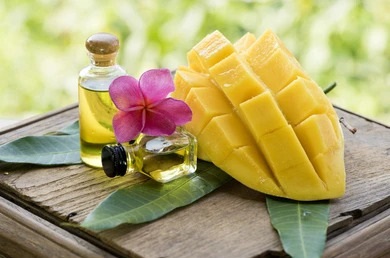Project Report For Mango Kernel Oil
Introduction
Project report for mango kernel oil is as follows.
Mango butter is processed to yield a percentage of oil known as mango oil. Mango oil is a seed oil obtained from the stone of the mango indica fruit. Mango oil is extracted from mango seeds by applying pressure; it has a lovely golden colour and a melting point between 23 and 27 °C. Despite the fact that it might be semi-soft at room temperature, mango oil has a lovely, flowing consistency. The oil is semi-solid and quickly absorbs into the skin. It is high in vitamins, minerals, and antioxidants. Mango oil can be used in any cosmetic process that requires the renewal and miniaturization of dry skin. Mango oil is useful in infant lotions, sunscreen, hair treatments, and other hydration goods. The majority of formulas use 3-10% mango oil.
An typical mango kernel has between 8% and 15% of potential for extraction (butter and oil). Normally discarded, this seed can be used in cosmetics and beauty items. Mango-based lotions, creams, balms, soaps, and hair conditioners often contain up to 3% to 12% mango kernel oil. The oil is not only a component of the aforementioned goods but also useful on its own. Typically, the pure form is added to bathwater, where its perfume wakes the senses as the oil works its magic to revitalize the body.

Product & Application of Mango Kernel Oil
Mango kernel oil, a byproduct of the mango fruit, is mostly used in the soap and cosmetics industries. Hydraulic pressing is one way of extracting the oil from mango kernels. Small-scale processors benefit more from hydraulic pressing since its initial and ongoing costs are significantly cheaper. In comparison to the screw press or solvent extraction procedures, it also offers pure cake residue and uncontaminated oil. The current study aims to gain a deeper understanding of the many process factors that affect the efficient production of cake and oil from higher-quality mango kernels utilising hydraulic pressing.
The mango kernel was hydraulically pressed using the Universal Testing Machine and a specialised test chamber. Mango kernels of the kesar type were employed for the experiment. Before the final research could start, numerous preliminary attempts were made to standardize the hydraulic pressing process in connection to the levels of pressing load and sample size of mango kernels. Based on preliminary tests and some prior research, an effort was made to look at how steaming mango kernels affected oil yield, oil recovery, and oil quality. Mango butter (mango kernel fat) is made from mango seed kernels (Mangifera indica). There are a great deal of mango trees and numerous regional varieties of the fruit in India.
Sample Project Report Of Mango Kernel Oil For Bank Loan
Get Completely Custom Bankable Project Report
The fruit is eaten as food and as a delicacy. Around 7 million tonnes of mangoes are thought to be produced annually in India. A mango has a single, ovoid, oblique seed that is also known as a stone. The latter has a kernel inside of a tough shell. Around one million tonnes of mango kernels might potentially be produced in the nation, which would produce 70,000 tonnes of mango kernel fat. 8–12% of mango fat is oil. The amount of stone, kernel, and fat in each of these components varies depending on the type of fruit. On a dry basis, fruit is made up of 4–14% stone, 61–83% kernels, and 7–11% fat.
Market Potential of Mango Kernel Oil
The global market for mango oil is anticipated to grow from USD 1.09 billion in 2018 to USD X.XX billion in 2030, at a CAGR of 8.5%.
Expenses

Product Cost Breakup

Reveneue Vs Expenses

Market Trend

India will have access to about 3 lakh tonnes of dried mango kernel each year, from which 30,000 tonnes of mango fat, currently worth 200 million rupees (Indian currency), might be produced. About 40–50% of the byproducts produced by the processing of mangoes. Cull fruits, mango seeds that make up 20–60% of the entire fruit (depending on variation), mango seed kernels that make up 47–75% of the entire seed, de-oiled mango kernel meal made from the leftover oil from the kernel extraction, and mango peels that make up 7–24% of the fruit are among these. These waste products are potential sources of pectin and phenolics as well as fodder for animals.
The oil produced when the mango seed is processed is known as mango kernel fat. The mango fruit’s stone or kernel is where the seed oil is found. When applied to the skin, the oil or butter melts from its semi-solid state. Mango oil has a melting point that lies between 90 and 109 degrees Fahrenheit. It is unfit for consumption since it contains a large amount of unsaturated fat and about 45% saturated fat. The market for mango seed butter and oil is expanding globally due to a number of factors.
